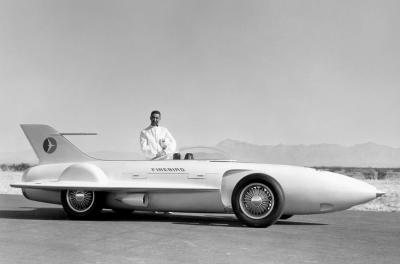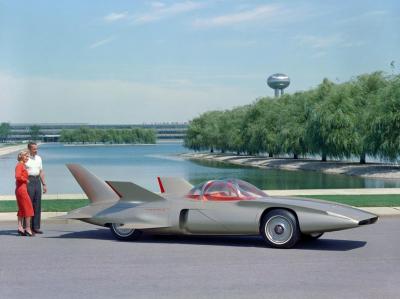A jet fighter but on 4 wheels

-
Category
-
Author
-
743
-
0
-
27Sep, 2022
The GM Firebird is the land-based incarnation of the jet-powered Douglas F4D Skyray.
Usually, the convergence of the worlds of cars and airplanes happens at the level of allegories, but seventy years ago, Americans almost managed to do it literally. It is symbolic that the era of the “Detroit Baroque” was standing in the yard - magnificent design in an aviation style. Huge imposing V8 barges of immodest displacement boasted tons of chrome decor and tail fins a la fighter jet plumage. Against the background of this vanity fair, the revolutionary project of General Motors looked like a marvel of technology stuck between earth and sky.
Actually, the name Firebird is not associated with aeronautics. It belonged to four generations of the once-famous Pontiac ponycar, the closest relative of the Chevrolet Camaro. The experimental and now forgotten namesake had appeared thirteen years earlier and would surely have delighted Jules Verne himself. It is symbolic that it was created by Jim's artist Harley Jarvis Earl, a romantic and dreamer with an individual vision of beauty.
In his younger years, a native of Hollywood could become a movie star and play the role of some kind of mafia type or politician - with his outrageous appearance, this would not be difficult. But Earl chose the family business and followed in the footsteps of his father, who first worked in the manufacture of horse-drawn carriages, and then switched to car bodies.
Circumstances not only favored cooperation with General Motors, absolutely all the stars agreed for this. Harley Jarvis remained in charge of the family business, Earl Automotive Works, even after being acquired by Cadillac dealer Don Lee. One truly beautiful day, the general manager of Cadillac and one of the founders of the Fisher Body body shop Lawrence Fisher visited the car dealership. He was introduced to Earl's work and saw in the young man, in his early thirties, an intelligent craftsman, a creative personality and a suitable candidate for the role of the designer of the first model of the luxury brand LaSalle, now long dead.
The Series 303 was somewhat reminiscent of the Hispano-Suiza H6, but as time passed, the maestro stopped looking around. In 1939, Earl's department tore the cover off the streamlined Buick Y-Job, in fact the first concept car in history. A decade later, Cadillac rolled out the third-generation Series 62, with small tailfins a la the plumage of the Lockheed P-38 Lightning twin-engine heavy fighter. Designed by Frank Hershey. Hardly anyone remembers him today.
Since that moment, aviation motifs have captured the imagination of design centers. The creations of the talented Chrysler Corporation artist Virgil Exner appeared on the scene, almost as good as GM products in pomposity. The peak of the "Detroit baroque" came in the second half of the fifties, when the giant tail fins were echoed by taillights a la rocket nozzles, and at the same time thematic decor on the sidewalls. And here let me draw your attention to an exciting circumstance: General Motors really dreamed of something very close to airplanes. They probed the ground, experimented and almost opened the door to an alternative reality.
The Firebird I (originally called XP-21) is a child of the romantic era, when tomorrow seemed bright, high-tech and reactive, and bold prophetic statements poured from every iron. As an example, and a slight lyrical digression, there is an article in The Tacoma News Tribune dated April 11, 1953 with the headline "In the future, there will be no end to telephones." It contains the president of Pacific Telephone & Telegraph Co. Mark Sullivan shared fantastically accurate thoughts on mobile devices with video communication.
But back to Firebird. It resembled a scaled down version of the Douglas F4D Skyray carrier-based interceptor with a delta wing mounted on four wheels. No more and no less. In his article “I Dream of Cars” for The Saturday Evening Post, Harley Earl talked about the origins of non-trivial design.
“Firebird inspires me with its origins. At our 1953 Motorama show, the main dream car was the Le Saber. And right after it was shown to company officials for the first time, I went on a plane trip. I opened the magazine and saw a picture of the new Douglas Skyray jet. This is an amazing ship, and I liked it so much that I ripped out the picture and stuffed it into the inside pocket of my coat. The GM rep who accompanied me came over to congratulate me on the Le Saber. "But what will you do next year?" - he asked. I had absolutely no idea at the time, but I patted my pocket where the Skyray image lay: "It's right here." It was a joke, I was just answering his questions in a similar manner. And then bingo! The result, as you can see, is the Firebird, a road replica aircraft."
The work of Earl and his guys brings to mind the words of the artist Brett Dilosanto from the book "Wheels" by Arthur Hailey. Here, listen: “... they will tell you that no major changes can be made to the model of the car. From now on, they say, we will only make minor modifications and develop existing designs. But that's exactly what the gas industry thought before Edison invented electricity. And I argue that fantastic changes are planned in design. And one of the reasons is that we'll be getting some amazing new content soon."
The General Motors project went beyond stylistic frills and primarily served as a research platform to dive into the then little-known field of ground vehicle aerodynamics. An almost exact scale copy was sent to the California Institute of Technology for testing in a wind tunnel and creating the optimal body shape, calculation of brake flaps and tail angles of attack.
External similarity with Skyray required a special power plant. And here it is exactly like this: under the fiberglass "fuselage" is a gas turbine engine. Prior to the birth of the Firebird, GM had been developing the GT-300 unit for testing on trucks and buses for several years. The prototype fighter received the GT-302 Whirlfire Turbo-Power with an idle speed of 8000 rpm and a power of 375 hp. at 26,000 rpm. Weight - 351.5 kg, which is 31% of the weight of the machine.
Here's how David Temple describes the device and how it works for Mechanix Illustrated. “In the bow of the Firebird is a 132-liter fiberglass fuel tank, and immediately behind the cabin is a two-section gas turbine engine with a gas generator and power section connected by a flexible shaft. The first actually replaces the internal combustion engine and the pump wheel of the automatic transmission torque converter, and the second - the turbine wheel, transmission and rear axle differential.
The rocket launcher sets the aircraft in motion due to the emission of gases (jet blast). In contrast, the Firebird motor directs its exhaust gases through a turbine, which is connected directly to the rear wheels through the transmission. The gas generating section consists of a compressor rotor and a turbine wheel on a common shaft. The air entering the compressor is compressed at a pressure 3.5 times higher than atmospheric pressure. Then it enters two combustion chambers and heats up to over 800 degrees. Hot gas from the gas generator turbine drives the power section turbine. This in turn drives the rear axle through a two-speed planetary gearbox.”
The estimated speed was seen somewhere beyond 320 km / h and significantly exceeded the record achievement of the British gas turbine Rover JET1 (152.691 miles per hour or 245.7 km / h). But the not-so-successful trip of GM Vice President and Research Laboratories Division General Manager Charles McKuen to the Arizona test site discouraged any desire to test it. After the turbine gained high speed, the "firebird" flew at full speed. McKuen released the accelerator pedal before the turn, but did not take into account that this type of installation does not provide engine braking. There was no time for slowing down, and as a result, the Firebird turned over. The pilot was injured, but survived thanks to a head restraint and seat belts, and the "rocket" was repaired and exhibited at the Motorama 1954 exhibition at the fashionable New York Waldorf Astoria hotel.
Road fighter turned out to be terrible? Not at all! According to three-time Indy 500 winner and engineer Maury Rose, who participated in the development, the Firebird is controlled and stable. Despite the “dampness” of the design, the front torsion bar suspension on double wishbones and the rear “De Dion” made it possible to achieve decent behavior. The brake system is quite interesting: drums with a diameter of 11 inches are placed not inside, but outside the wheel for the fastest and most efficient heat dissipation.
“With absolute sincerity, I can say that the car itself is an outstanding work both in terms of style and engineering,” Rose said in a Motor Life article.
The concept of a gas turbine vehicle captured the people of General Motors so much that in 1956 they introduced the Firebird II (XP-43). This time, not for egoists, but in the name of… family values! The length of the aircraft-like body with a four-seat interior is almost six meters. The Whirlfire GT-304 (203 hp at 28,000 rpm) is more efficient, economical and quieter than the previous monster, and the exhaust gas temperature has dropped to the level of the internal combustion engine.
The second iteration turned out to be prophetic in a certain sense. It's not about gas-oil chambers instead of springs and shock absorbers with the ability to maintain a constant ground clearance, regardless of the load. Not in experimental disc brakes. And not even in the air conditioner, which is vital in a glass cabin with a "greenhouse effect". Dr. Lawrence Hafstad, Vice President of GM Research Laboratories, and his team have virtually equipped the Firebird II with unmanned technology and integrated it into the automated road infrastructure of the future.
For autonomous movement, the driver turns on the toggle switch and "fits" into the transport system with impulse strips. The incoming electronic signals control steering, acceleration and braking via the on-board computer. People, meanwhile, go about their business, reading books, watching TV, or just staring around. An important role in the futuristic show is played by control room operators - according to legend, they help with finding free rooms in roadside motels, and can also control the fuel level and engine operation, synchronize the speed and direction of movement, or, in case of a malfunction, remotely direct the car to a safe place.
In 1958, Harley Earl left General Motors and left in his legacy the Firebird III, "an entirely new type of vehicle that can be used to get to the moon launch pad." By the way, the Jeim miracle itself resembled a spacecraft with cockpit hemispheres and seven tail fins.
The more compact and lighter gas turbine GT-305 (228 hp at 33,000 rpm) with a quarter improvement in efficiency was assisted by a 10 hp two-cylinder aluminum engine. for driving air suspension, air conditioning and other electrical and hydraulic on-board systems. Isn't it remotely reminiscent of the scheme of sequential hybrids, when the internal combustion engine is in no way connected with the wheels, but is only a generator for the traction battery?
Without cruise control and anti-lock brakes included in the Firebird III equipment, modern technology is unthinkable. But the exotic Unicontrol joystick with which the aircraft accelerated, turned and slowed down until it found application.
It is rather strange to see axle beams on subframes in the midst of this high-tech, but there is a nuance here: the front and rear gas-oil elastic elements are combined with each other to increase smoothness, reduce disturbances from the road surface and maintain a constant ground clearance.
The fourth Firebird of 1964 will be bracketed out as it is not a functional layout. Although, of course, beautiful!























